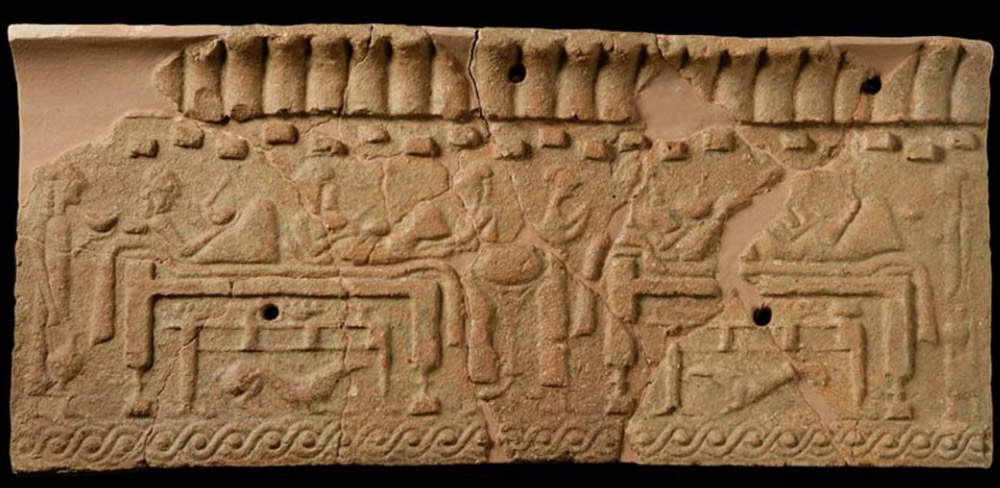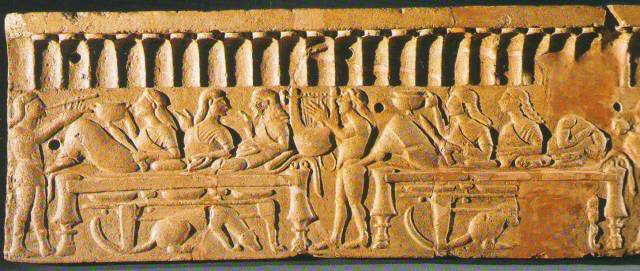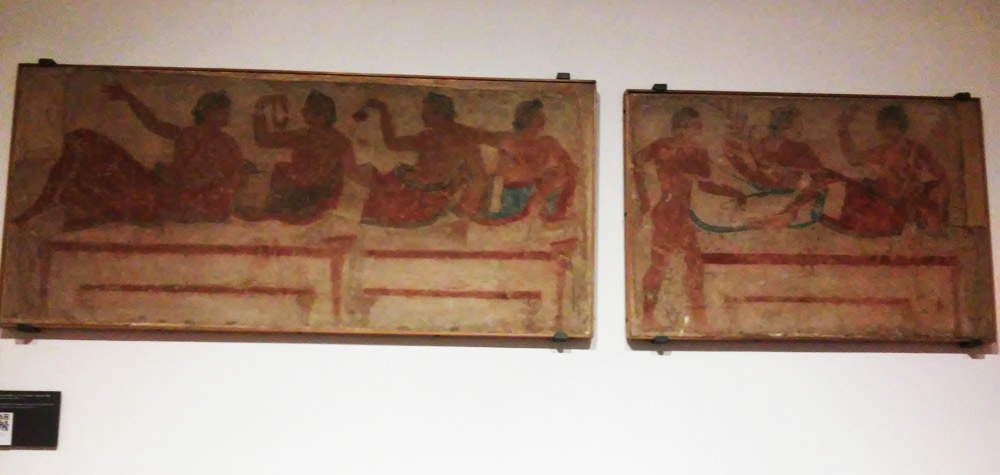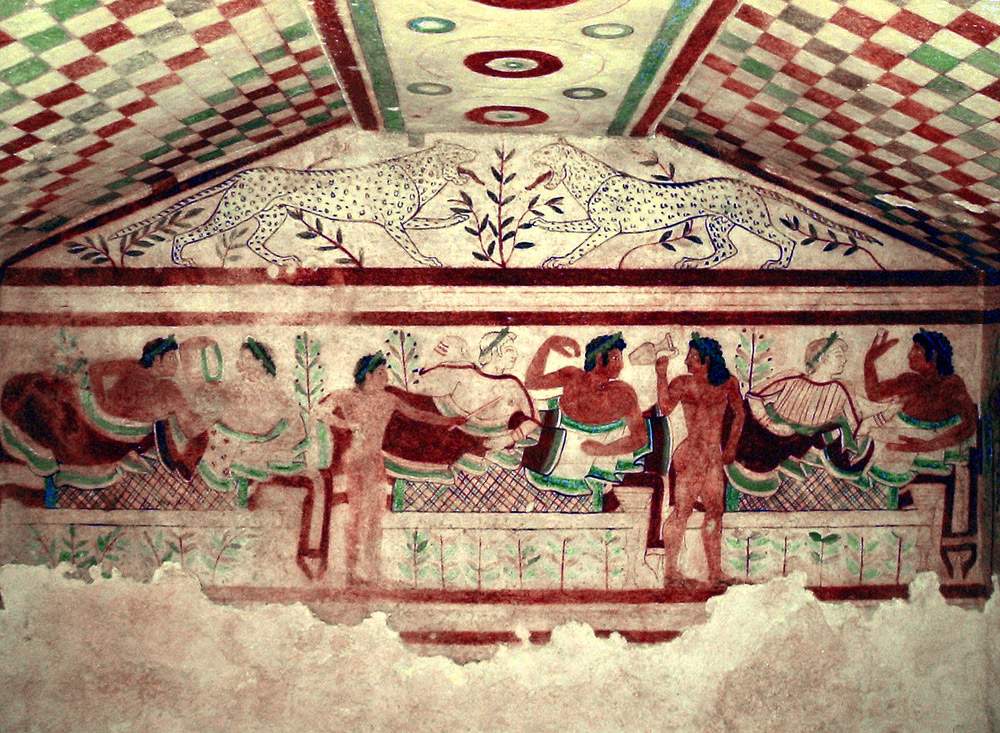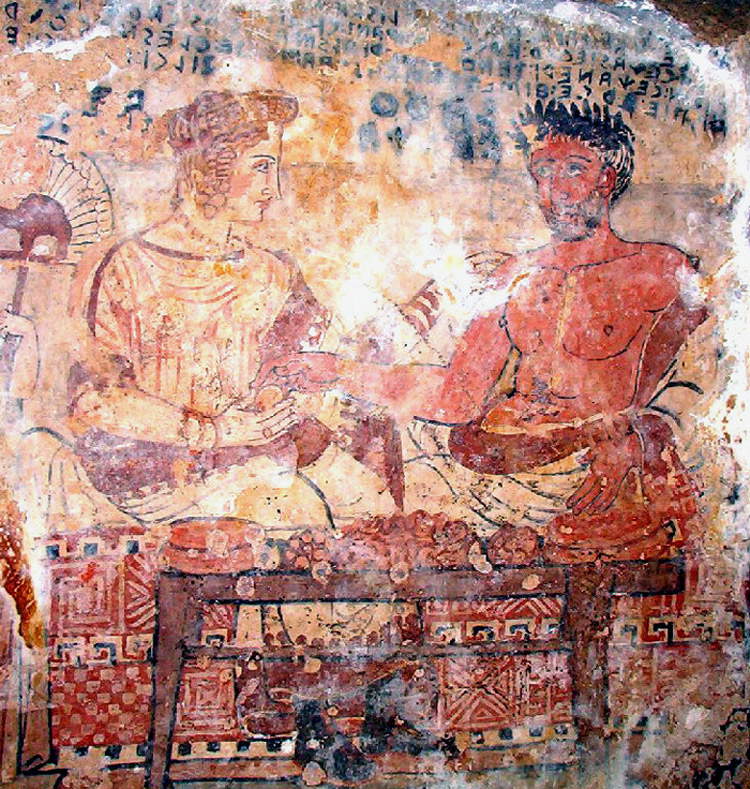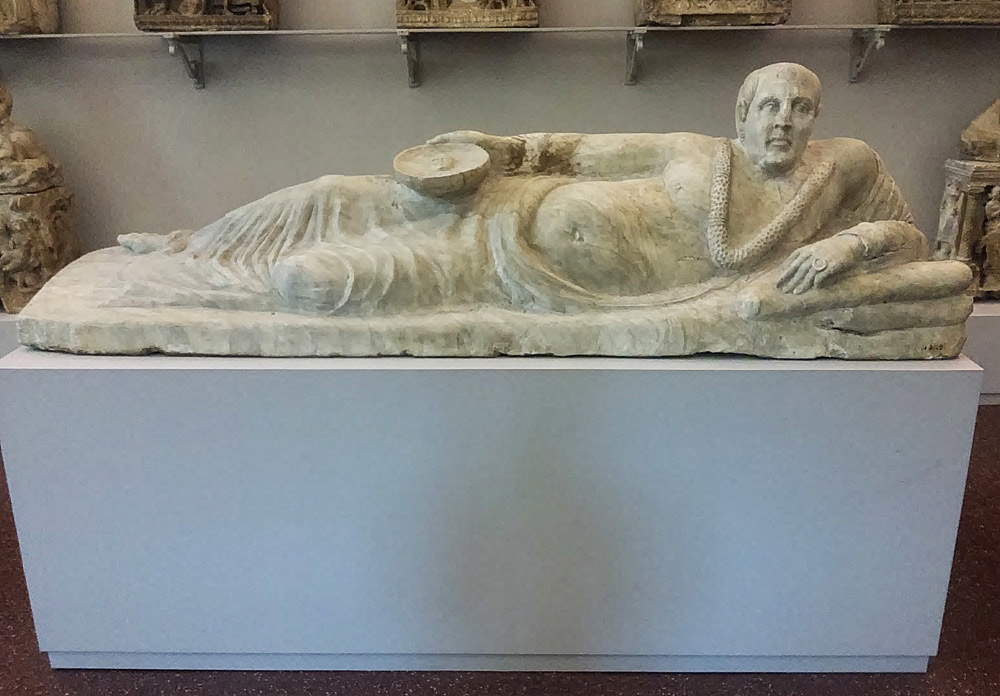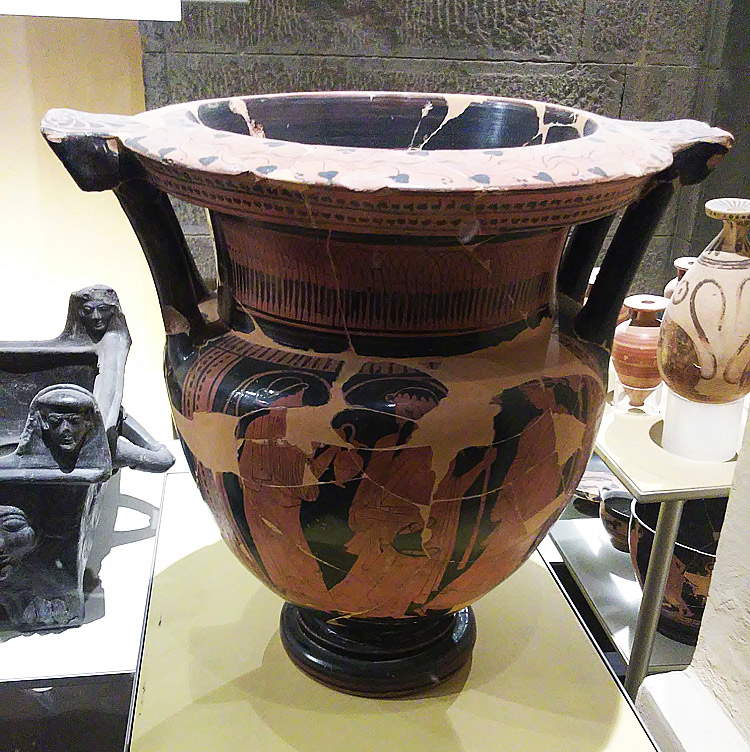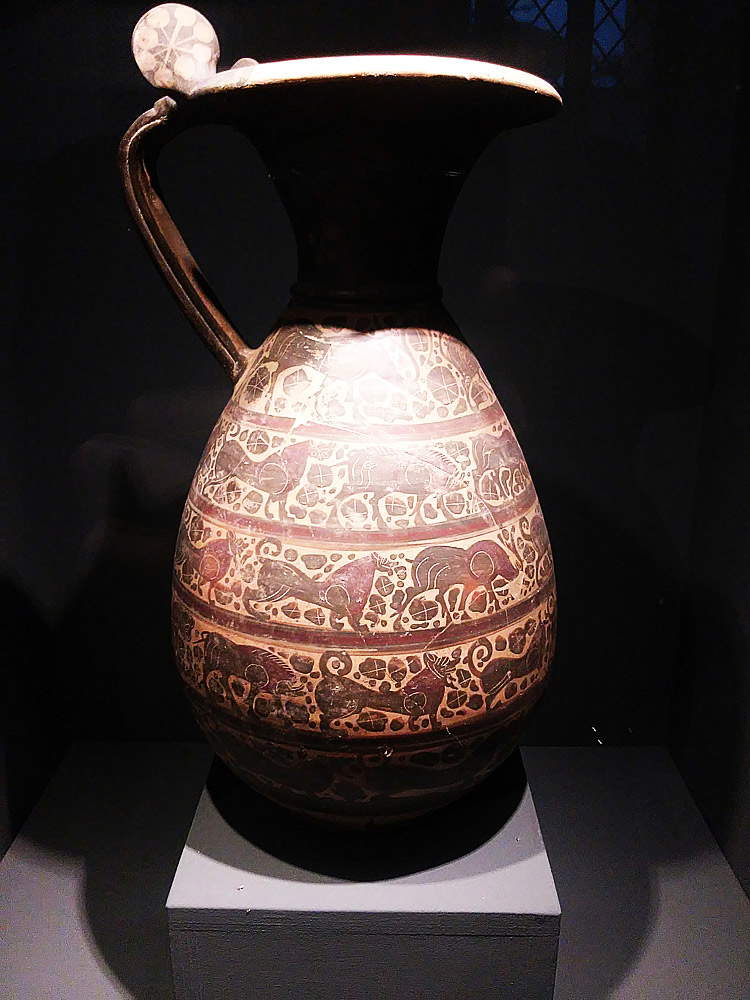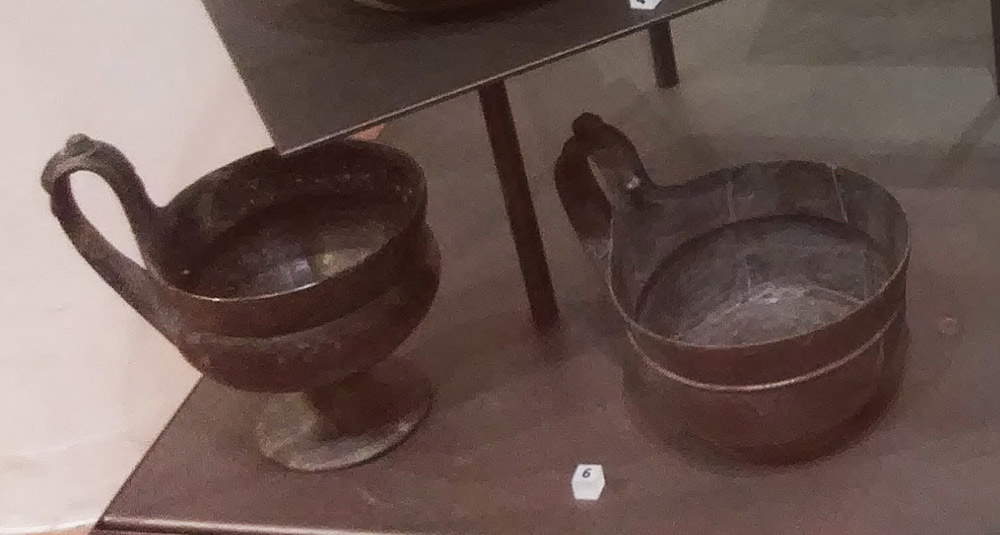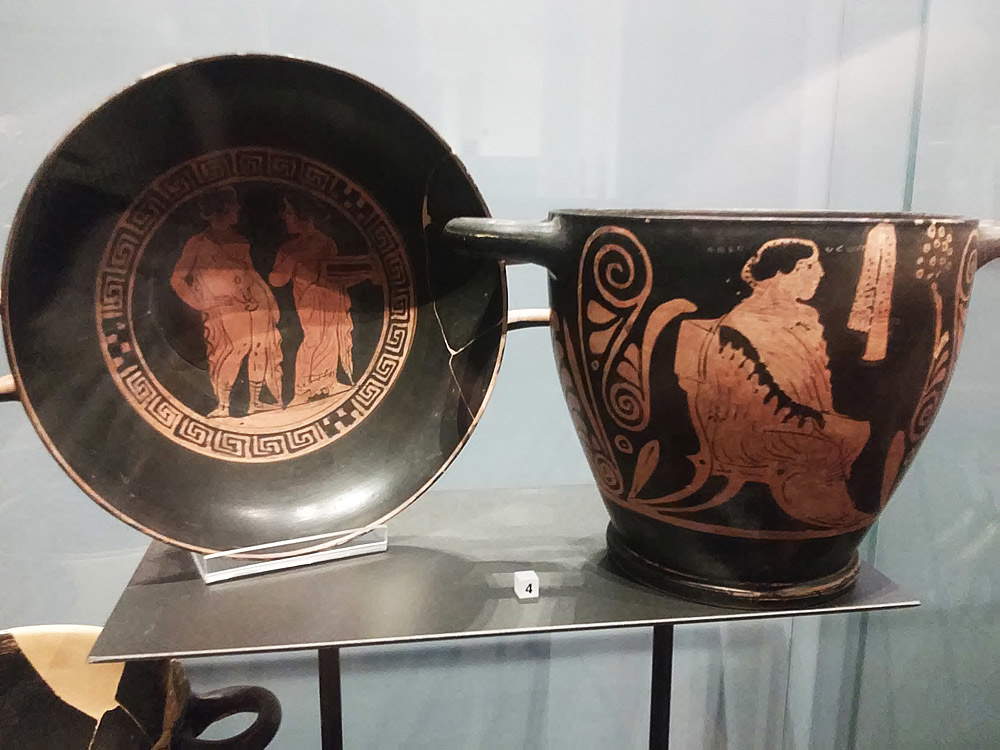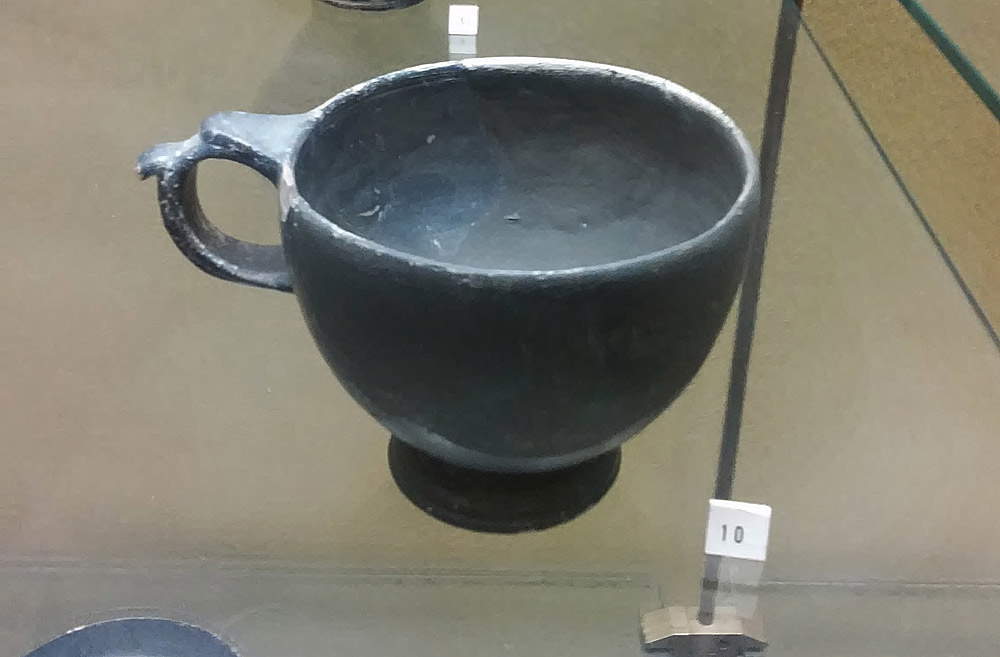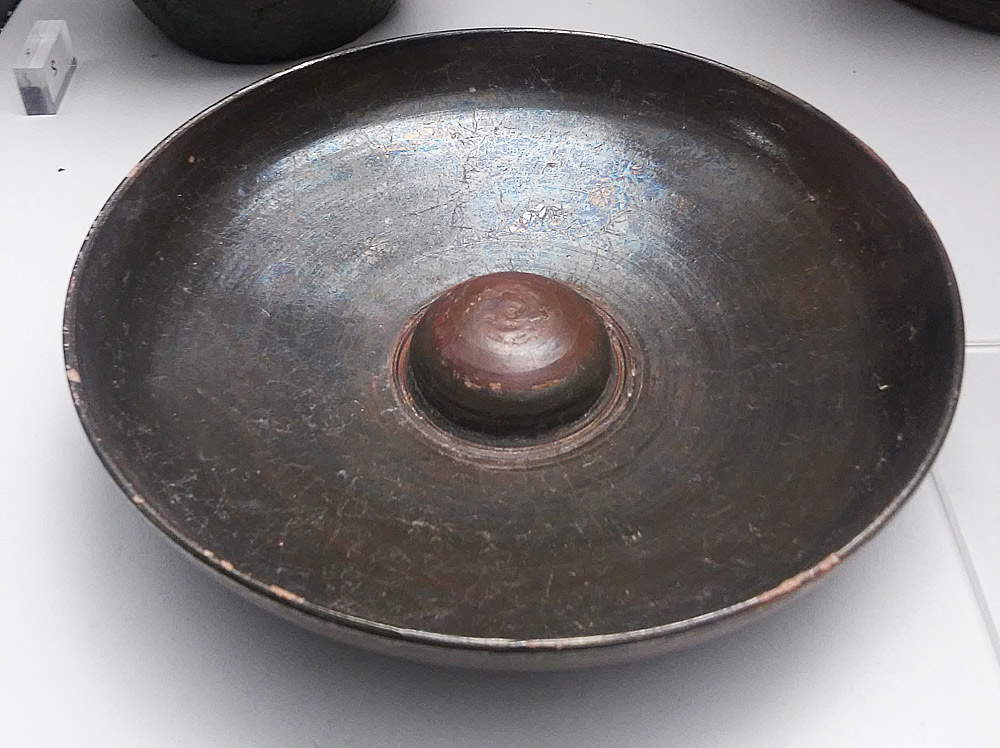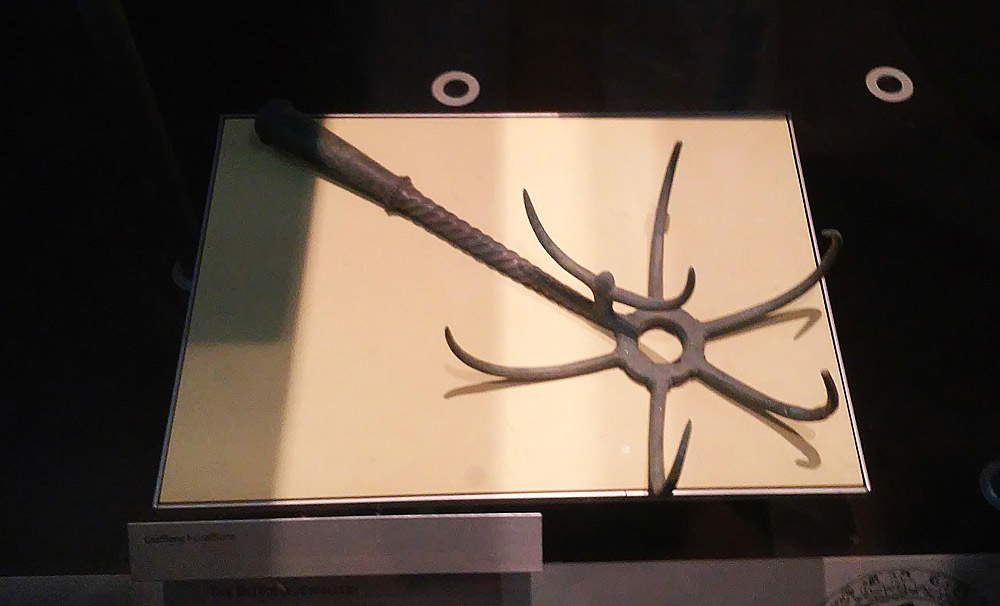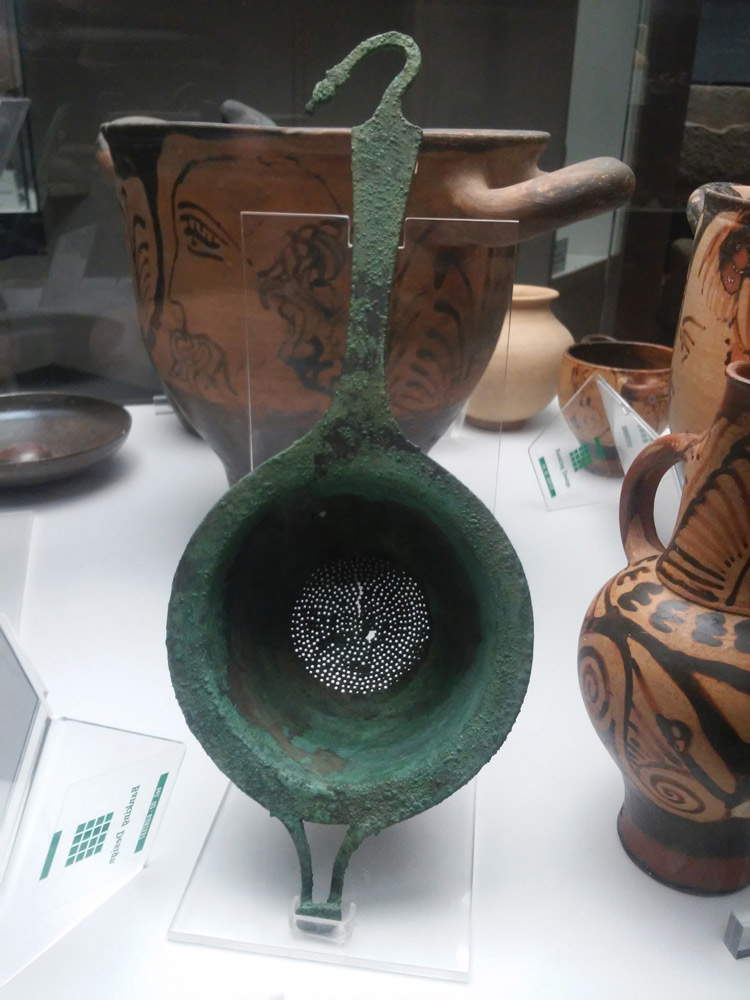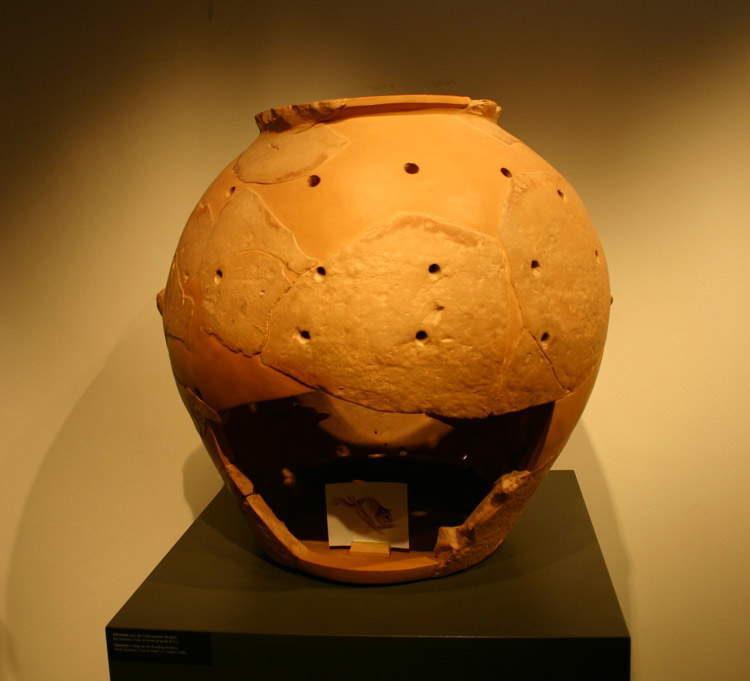by Federico Giannini, Ilaria Baratta, published on 30/05/2018
Categories:
Works and artists
- Quaderni di viaggio / Disclaimer
Etruscan cuisine: what the Etruscans ate, with what, what tools, banquets and symposia. An in-depth look at the Etruscans at the table!
Many poets and prose writers of antiquity celebrated the splendors and splendors of the banquets of the Etruscans. An author such as Diodorus Siculus, quoting Posidonius, returned to us a rather detailed description of the convivial atmosphere that must have been felt at an opulent Etruscan banquet: “they prepare twice a day sumptuous tables and all other things appropriate to excessive luxury, setting up banquets with colorful linens and embroidery, silver cups of various kinds, and have ready and at their disposal no small number of servants to serve them, some of the latter being of extraordinary loveliness, while others are adorned with more sumptuous robes than would be appropriate to their condition as servants.” The Etruscans knew two types of banquet: the banquet proper, and the symposium. The difference was that during the symposium they only drank, while at the banquet they drank and ate, and usually the symposium followed the banquet. If we were to make a comparison with our present-day customs, we could compare the banquet to a dinner party, and the symposium to an after-dinner party, partly because the purposes were more or less similar: the banquet was a time for conviviality, and depending on the courses that appeared on the table it could also constitute a clear demonstration of wealth. The symposium, on the other hand, was dedicated to entertainment: just as we, today, go to the pub to see a live music concert while sipping our favorite cocktail, a glass of wine or a glass of beer, in the same way the Etruscans, after dinner, liked to attend small music or dance performances while toasting generously with good wine.
From the depictions that have remained to us we also know how a banquet was supposed to take place. Participants would arrange themselves around the table by lying on special banquet beds, which were called klínai and were typical of ancient Greece: however, unlike in Greece, where the banquet was reserved for men only, in Etruria even women could lie on the klínai and participate in the banquet. The earliest depiction of a banquet in which the participants lie on the klínai is found in one of the slabs of the Murlo frieze, dating from the first half of the sixth century B.C.E. Interestingly, the Etruscologist Annette Rathje wanted to identify, in the second character lying on the bed, a female individual. The Murlo slab, in addition to being the oldest depiction of an Etruscan banquet “lying down,” would also be the first depiction to include a woman in such a context: a sign that already in very ancient times the Etruscans granted women a role or relevance that was unparalleled in the societies of their contemporaries. Similar scenes are found in various representations, however, since the banquet (or symposium) motif became one of the most frequent in Etruscan art. Thus we find it in the frescoes of the Tomb of the Hill, currently preserved in the National Etruscan Museum in Chiusi (it is a symposium scene: the participants, in fact, are all engaged in drinking), or in the Acquarossa slabs, preserved at the National Etruscan Museum in Viterbo, or again in the frescoes of the tombs of Tarquinia, for example in the Tomb of the Leopards, where we witness a symposium animated by musicians, or in the Tomb of the Shields, where the protagonist is a couple, husband and wife, who are feasting by sharing a single klíne in front of which a small table full of food is set. At the Archaeological Museum in Chianciano Terme, visitors can instead find a reconstruction of the hall of an Etruscan dwelling set up for a banquet, complete with klínai and set tables.
Banquets were, however, occasions exclusively reserved for the higher social classes who, as might be expected, also had very different eating habits than those of the lower strata of Etruscan society. Nevertheless, there was a belief among the Romans that the Etruscans spent their lives eating and drinking, so much so that the stereotype of theobese Etruscan was widespread, which has been transmitted to us by poets such as Catullus (who in carme XXXIX of his Nugae speaks in clear terms of theobesus etruscus) or Virgil (who, in the second Georgica, in turn cites the commonplace of the pinguis Tyrrhenus). If we look at some of the evidence of Etruscan art that has come down to us, it will be difficult to blame Catullus and Virgil: the sarcophagi of the Etruscans sometimes feature figures of clearly overweight figures, moreover almost always arranged on the sarcophagus as if they were feasting. This way of depicting the deceased had the specific intent of establishing a kind of continuity between earthly life and life in the afterlife, and it is for this reason that the sarcophagi were intended to represent real moments of daily life, with the result that, wrote the archaeologist Mario Ersamo, “walking into a tomb with the sarcophagi/portraits arranged in front of the entrance [...] elicited the effect of being in the middle of a room where a banquet was in progress and interrupting a dinner and conversation that was already taking place, and which the inhabitants of the tomb are fully enjoying.” About the fatness of certain characters, in defense of the Etruscans, however, it must be stated with certainty that there are not many characters who display conspicuous fatness, and that this characteristic should be read more as an individual connotation of a certain character than as a common feature of most Etruscans. The most famous “obesus etruscus” is certainly, indeed, the so-called Obeso from the National Archaeological Museum in Florence: the character, who decorates the lid of a sarcophagus from the first half of the third century B.C., is a member of theChiusi aristocracy, who shows obvious signs of wealth (not only the roundness of his body, but also the conspicuous garland around his neck and the large ring on his left ring finger). We cannot say, however, whether the sarcophagus constitutes a faithful portrait of the deceased, or embodies, if anything, a type, since in any case plumpness was indicative of opulence.
 |
| Etruscan art, Slab with banquet scene (6th century BC; terracotta; Murlo, Antiquarium of Poggio Civitate - Archaeological Museum) |
 |
| Etruscan art, Acquarossa slab with banquet scene (6th century BC; terracotta; Viterbo, Museo Nazionale Etrusco) |
 |
| Banquet scenes from the Hill Tomb (c. 470 BC; frescoes; Chiusi, National Etruscan Museum). Ph. Credit Finestre Sull’Arte |
 |
| Etruscan Art, Banquet Scene (473 BC; fresco; Tarquinia, Tomb of the Leopards) |
 |
| Etruscan Art, Banquet Scene (third quarter of 4th century BC; fresco; Tarquinia, Tomb of the Shields) |
 |
| Reconstruction of Etruscan banquet at the Archaeological Museum of Chianciano Terme |
 |
| Sarcophagus “called of the Obese” (first half of 3rd century BC; Florence, Museo Archeologico Nazionale). Ph. Credit Finestre Sull’Arte |
But what could be found on an Etruscan banquet table? Let’s start by looking at what items the Etruscans brought to the table, and then focus on their favorite dishes. If we imagined entering the dining room of a wealthy Etruscan dwelling of two and a half thousand years ago, we would find a table filled with vessels, vases, pitchers, all with clearly recognizable shapes, and dedicated to a very specific function. The tableware of the Etruscans, according to the classification of the Etruscologist Giovanni Colonna, compiled in the 1970s but according to many scholars still valid today, can be divided into three main types: vessels for containing, vessels for drinking, and vessels for pouring. They were almost all of Greek origin, so much so that, incommon usage, they are referred to by the corresponding Greek terms and not by the Etruscan ones, which are attested less frequently and often in an uncertain manner. Containing vessels, which also had the function of mixing drinks (the Etruscans, like the Romans, were not accustomed to drinking straight wine: they diluted it with water), did not appear on the table but were nonetheless indispensable: ollae (large vessels with two handles, ancestors of today’s pots: in Etruscan they were called thina) and píthoi (a term of Greek origin for large vessels without handles instead, in Etruscan larnas: these were jars where oil, drinks and foods such as grains were stored) were typical. A particular type of vessel for containing (which can, however, also be classified only as a mixing vessel) was the crater, the most refined type: derived from the olla, it was the typical vessel of the symposium as it contained the wine that was drawn from the diners. Then there was a large container for water: it was called hydría and could reach considerable size ( hydríai more than half a meter high were not uncommon).
On the table, on the other hand, it was possible to find pouring vessels and drinking vessels. Belonging to the first group is theoinochóe (in Etruscan qutum or pruchum), the ancestor of modern jugs: this was a small vessel with a globular body and a narrow neck, which could be more or less elongated, with a loop. It was a vessel used for pouring water or wine into the cups of diners: there are many of these in archaeological museums throughout Italy and they could also be variously decorated. Similar to theoinochóe in use and shape was the olpe, a vase that differed from the former in that it was slimmer and had a circular mouth, as opposed to theoinochóe, which instead had a spout. Somewhere between the pouring vessel and the drinking vessel lies the kyáthos: it was a kind of cup with a long handle that was used to draw wine from the crater and pour it into the cups of the diners (we can consider it an ancestor of the modern ladle, but with a larger body, and which could be decorated). As for drinking vessels, there were four main types. Most common was the chalice without handles: it was an object quite similar to modern chalices, with a body designed to hold the drink, and a stem with a foot that was used to rest it on the table (in Etruscan, the chalice was called a thavna). Another type was the kántharos (in Etruscan zavena), a drinking cup that resembled a chalice (but larger), with two handles: the diner typically held it with a closed hand by one of the two handles. In contrast, the skyphos, the most direct ancestor of modern cups, was a small cup used for drinking milk, had two small handles (and it is amusing to see how the skyphoi that have come down to us without a handle resemble modern coffee cups). Finally, the kylix was a flat-shaped cup typically used for libations during symposia. Both skyphos and kylix in Etruscan were designated by the term culichna. A particular type of cup, however, used primarily in a ritual function, was the pàtera: halfway between a cup and a dish, it was a kind of very low bowl (almost a plate), which had a rise in the center corresponding to a hole in the back (the hole was for the diner to grasp). We see it appear often in sarcophagi (the “obeso” of Florence itself is an example): its role was in fact related to sacrifices and ritual libations held in honor of deities.
All the vases listed above were typically made of pottery, but bronze ones have also been found. Typically Etruscan was bucchero pottery, a black-bodied, highly refined pottery that was made from very fine clay mixtures fired in kilns suitable for reductive firing, that is, at a low oxygen level. This type of firing ensured chemical reactions that led to the characteristic shiny black coloration that distinguishes Etruscan bucchero. Finally, it is interesting to note that, to eat, the Etruscans used plates, but they did not make use of cutlery: they took food directly with their fingers, and, in the homes of the wealthiest, attendants were ready when needed with containers of water and wipes. Forks have been found, showing that in any case the Etruscans were familiar with this tool: however, they were used in the kitchen for grasping and did not appear on the table. It was therefore assumed that food was brought to the table already broken, also because knives were not present on the Etruscan table either (they too were used exclusively in the kitchen). The same goes for spoons: their use at the table was not contemplated. However, many utensils were widely used in the kitchen: not only objects with a shape reminiscent of today’s kitchen utensils (such as the earthenware bells in which food was cooked, or such as the graffione, a tool whose use is still unclear today, but it may have been a kind of large spit with a horizontal handle and hooks to which the meat to be cooked was attached), but also tools identical to those we use today, such as pestles, strainers, stoves, and graters (the latter were mainly used to grate the spices with which wine was flavored).
 |
| Olla (mid-6th century B.C.; terracotta; Chiusi, National Etruscan Museum). Ph. Credit Finestre Sull’Arte |
 |
| Camucia painter, Columned krater (460-450 BC; Attic red-figure pottery; Cortona, Museo dell’Accademia Etrusca). Ph. Credit Finestre Sull’Arte |
 |
| Hydria (480-380 BC; painted red-figure pottery, height 36 cm; Vatican City, Vatican Museums) |
 |
| Oinochoe (6th century B.C.; bucchero; Florence, Museo Archeologico Nazionale). Ph. Credit Francesco Bini |
 |
| Olpe (first half of 7th-second quarter of 6th century BC; pottery; Florence, Museo Archeologico Nazionale) |
 |
| Goblets with cylinder decoration (Bucchero; Bologna, Museo Civico Archeologico) |
 |
| Kantharoi (late 7th-early 6th century BC; bucchero; Chiusi, Museo Nazionale Etrusco). Ph. Credit Finestre Sull’Arte |
 |
| Kyathoi (late 7th - early 6th century BC; bucchero; Chiusi, Museo Nazionale Etrusco). Ph. Credit Finestre Sull’Arte |
 |
| On the left is a kylix and on the right is a skyphos (5th-4th century B.C.; Etruscan red-figure pottery; Chiusi, Museo Nazionale Etrusco). Ph. Credit Finestre Sull’Arte. |
 |
| Skyphos lacking right handle (bucchero; Bolsena, Museo del Territorio). Ph. Credit Finestre Sull’Arte |
 |
| Patera ombelicata (4th century B.C.; black-glazed pottery; Viterbo, Museo Civico). Ph. Credit Finestre Sull’Arte |
 |
| Graffione (bronze; Cortona, Museum of the Etruscan Academy). Ph. Credit Finestre Sull’Arte |
 |
| Grater (late 6th century B.C.; bronze; Chiusi, Museo Nazionale Etrusco). Ph. Credit Finestre Sull’Arte |
 |
| Colino (4th century BC; bronze; Viterbo, Museo Civico). Ph. Credit Finestre Sull’Arte |
Finally, what were the Etruscan recipes that stimulated the palates of the ancient inhabitants of central Italy? The upper classes had access to many foods, and their members consumed large quantities of meat of all kinds. From the many skewers found, we can imagine that the Etruscans liked roasts very much: the most popular meat was pork, an animal from which they also made cured meats (pork farming, we know from Latin literary sources, was widely practiced in Etruria). But the Etruscans also raised sheep (excellent cheeses were made from the milk), horses and cattle, although the latter were used mainly for agricultural activities and were rarely slaughtered. Also highly prized was game, which, as is the case today, was flavored with bay leaves: roe deer, wild boar, deer and hare not infrequently appeared on the tables of the Etruscans with greater economic means. The less wealthy, on the other hand, were content with game that could be hunted with less expense: mainly birds. The coastal populations, on the other hand, practiced fishing, and the favorite fish of the Etruscans was tuna, as evidenced by several writers of antiquity who tell us how widespread tuna fishing was on the Tuscan coast. Among the peculiarities of Etruscan cuisine that have been lost, however, was the consumption of dormouse meat (which is illegal in Italy today): the cute rodents were fattened, in special large jars with holes in them to allow the passage of air (the vessel for raising dormice was called a glirarium: one of the best preserved ones is in the National Etruscan Museum in Chiusi), and then used for spit-roasting (this was a highly prized meat). The main condiment (besides, of course, salt) wasolive oil: even today Tuscany, Latium and Umbria, the regions where the Etruscan presence was strongest, provide almost 10 percent of Italian oil production. Spices and flavorings were also used to flavor meats.
 |
| A glirarium (late 2nd-early 1st century BC; terracotta; Chiusi, Museo Nazionale Etrusco). Ph. Credit Marco Daniele |
The cuisine of the lower segments of the population, on the other hand, obviously knew less variety. Poor dishes typical of the Etruscan tradition were puls, a widely used spelt polenta, which originated in Chiusi but was also consumed in other parts of Etruria (it was probably the staple dish of the Etruscan diet) and which could be seasoned with meat or vegetable sauces, and farrago, a soup of spelt, cereals and legumes. Breads and flatbreads, made from various types of flour obtained from cereals or legumes, and dairy products, which were obtained from the milk of sheep, goats and cattle, were also very common: particularly renowned and mentioned by Latin authors were the cheeses produced in the area of Luni, on the border between today’s Liguria and Tuscany. Excavations have also shown that the Etruscans were large consumers of fruit: figs, plums, pomegranates, pears and dried fruits such as hazelnuts, walnuts and chestnuts were foods often found on Etruscan tables. And again, the Etruscans ate a lot of legumes: chickpeas, beans, lentils, and broad beans. Eggs, another food much consumed by the Etruscans, could be eaten on their own, perhaps boiled, or used as a base for various recipes, for example for savory omelets, or for cakes that were then sweetened with the addition of honey, which the Etruscans, skilled beekeepers, produced in abundance: the cakes, moreover, could also be filled (typically with cheese mixed with honey).
To conclude, a brief mention of wine, the favorite drink of the Etruscans. Viticulture was widely practiced, and many ancient authors wrote about Etruscan wine. However, the wine drunk by the ancient inhabitants of Etruria was different from what we drink today: it was thicker and of higher alcohol content (which is why it was watered down before being consumed), and it was typically flavored (for example, with honey or, as was the case in Greece, with resin). It was so good and the production so abundant, that it was also exported to Sicily, Corsica, and southern Gaul: it was one of the absolute most exported products by the Etruscans. And it is perhaps superfluous to specify how wine was the great protagonist of banquets and symposia, whether they had convivial purposes or were convened for ritual purposes to pay homage to a god: and perhaps no other food came to touch the importance that wine held for Etruscan culture.
Reference bibliography
- Luana Kruta Poppi, Diana Neri (eds.), Donne dellEtruria padana dallVIII al VII secolo a.C.. Between domestic management and craft production, exhibition catalog (Castelfranco Emilia, Museo Civico Archeologico, Palazzo Piella, February 15 to March 10, 2015), All’Insegna del Giglio, 2015
- Mario Erasmo, Death: Antiquity and Its Legacy, Oxford University Press, 2012
- Giovanni Di Pasquale (ed.), Vinum nostrum: art, science and myths of wine in ancient Mediterranean civilizations, exhibition catalog (Florence, Museo degli Argenti, from July 20, 2010 to April 30, 2011), Giunti, 2010
- Vincenzo Bellelli, Enrico Benelli, A specialized sector of the Etruscan lexicon: a fine-tuning on the names of vessels in Quaderni annuali dell’Istituto di Studi sul Mediterraneo antico, VI (2009), pp. 139-152
- Jean-Marc Irollo, The Etruscans: at the origins of our civilization, Daedalus, 2008
- Ninina Cuomo di Caprio, Ceramics in archaeology, 2: ancient working techniques and modern methods of investigation, L’Erma di Bretschneider, 2007
- Antonio Giuliano, Giancarlo Buzzi, Etruschi, Mondadori-Electa, 2002
- Girolamo Zampieri, Ancient Bronzes from the Archaeological Museum of Padua, L’Erma di Bretschneider, 2000
- Antonia Rallo, Women in Etruria, L’Erma di Bretschneider, 1989
- Massimo Pallottino, Rasenna: history and civilization of the Etruscans, Scheiwiller, 1986
- Maria Bonghi Jovino, The Etruscans of Tarquinia, Panini, 1986
- Gabriele Cateni, Etruscans: scenes of daily life, Pacini Editore, 1984

The author of this article: Federico Giannini e Ilaria Baratta
Gli articoli firmati
Finestre sull'Arte sono scritti a quattro mani da
Federico Giannini e
Ilaria Baratta. Insieme abbiamo fondato
Finestre sull'Arte nel 2009.
Clicca qui per scoprire chi siamo
Warning: the translation into English of the original Italian article was created using automatic tools.
We undertake to review all articles, but we do not guarantee the total absence of inaccuracies in the translation due to the program. You can
find the original by clicking on the ITA button. If you find any mistake,please contact us.
